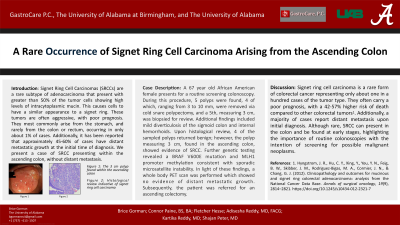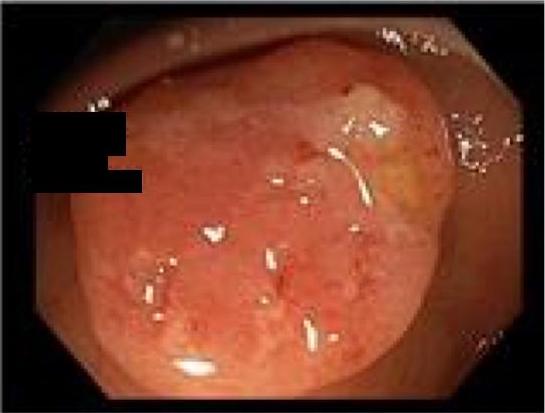Monday Poster Session
Category: Colon
P2099 - A Rare Occurrence of Signet Ring Cell Carcinoma Arising From the Ascending Colon
Monday, October 28, 2024
10:30 AM - 4:00 PM ET
Location: Exhibit Hall E

Has Audio

Brice Gorman
University of Alabama
Tuscaloosa, AL
Presenting Author(s)
Brice Gorman, 1, Connor Paine, BS, BA1, Fletcher Hesse, 1, Adisesha Reddy, MD, FACG2, Kartika Reddy, MD2, Shajan Peter, MD3
1University of Alabama, Tuscaloosa, AL; 2GastroCare P.C., Tuscaloosa, AL; 3Basil I. Hirschowitz Endoscopic Center of Excellence, The University of Alabama at Birmingham Heersink School of Medicine, Birmingham, AL
Introduction: Signet Ring Cell Carcinomas (SRCCs) are a rare subtype of adenocarcinoma that present with greater than 50% of the tumor cells showing high levels of intracytoplasmic mucin. This causes cells to have a similar appearance to a signet ring. These tumors are often aggressive, with poor prognosis. They most commonly arise from the stomach, and rarely from the colon or rectum, occurring in only about 1% of cases. Additionally, it has been reported that approximately 45-60% of cases have distant metastatic growth at the initial time of diagnosis. We present a case of SRCC presenting within the ascending colon, without distant metastasis.
Case Description/Methods: A 67 year old African American female presents for a routine screening colonoscopy. During this procedure, 5 polyps were found, 4 of which, ranging from 3 to 10 mm, were removed via cold snare polypectomy, and a 5th, measuring 3 cm, was biopsied for review. Additional findings included mild diverticulosis of the sigmoid colon and internal hemorrhoids. Upon histological review, 4 of the sampled polyps returned benign; however, the polyp measuring 3 cm, found in the ascending colon, showed evidence of SRCC. Further genetic testing revealed a BRAF V600E mutation and MLH1 promoter methylation consistent with sporadic microsatellite instability. In light of these findings, a whole body PET scan was performed which showed no evidence of distant metastatic growth. Subsequently, the patient was referred for an ascending colectomy.
Discussion: Signet ring cell carcinoma is a rare form of colorectal cancer representing only about one in a hundred cases of the tumor type. They often carry a poor prognosis, with a 42-57% higher risk of death compared to other colorectal tumors1. Additionally, a majority of cases report distant metastasis upon initial diagnosis. Although rare, SRCC can present in the colon and be found at early stages, highlighting the importance of routine colonoscopies with the intention of screening for possible malignant neoplasms.

Disclosures:
Brice Gorman, 1, Connor Paine, BS, BA1, Fletcher Hesse, 1, Adisesha Reddy, MD, FACG2, Kartika Reddy, MD2, Shajan Peter, MD3. P2099 - A Rare Occurrence of Signet Ring Cell Carcinoma Arising From the Ascending Colon, ACG 2024 Annual Scientific Meeting Abstracts. Philadelphia, PA: American College of Gastroenterology.
1University of Alabama, Tuscaloosa, AL; 2GastroCare P.C., Tuscaloosa, AL; 3Basil I. Hirschowitz Endoscopic Center of Excellence, The University of Alabama at Birmingham Heersink School of Medicine, Birmingham, AL
Introduction: Signet Ring Cell Carcinomas (SRCCs) are a rare subtype of adenocarcinoma that present with greater than 50% of the tumor cells showing high levels of intracytoplasmic mucin. This causes cells to have a similar appearance to a signet ring. These tumors are often aggressive, with poor prognosis. They most commonly arise from the stomach, and rarely from the colon or rectum, occurring in only about 1% of cases. Additionally, it has been reported that approximately 45-60% of cases have distant metastatic growth at the initial time of diagnosis. We present a case of SRCC presenting within the ascending colon, without distant metastasis.
Case Description/Methods: A 67 year old African American female presents for a routine screening colonoscopy. During this procedure, 5 polyps were found, 4 of which, ranging from 3 to 10 mm, were removed via cold snare polypectomy, and a 5th, measuring 3 cm, was biopsied for review. Additional findings included mild diverticulosis of the sigmoid colon and internal hemorrhoids. Upon histological review, 4 of the sampled polyps returned benign; however, the polyp measuring 3 cm, found in the ascending colon, showed evidence of SRCC. Further genetic testing revealed a BRAF V600E mutation and MLH1 promoter methylation consistent with sporadic microsatellite instability. In light of these findings, a whole body PET scan was performed which showed no evidence of distant metastatic growth. Subsequently, the patient was referred for an ascending colectomy.
Discussion: Signet ring cell carcinoma is a rare form of colorectal cancer representing only about one in a hundred cases of the tumor type. They often carry a poor prognosis, with a 42-57% higher risk of death compared to other colorectal tumors1. Additionally, a majority of cases report distant metastasis upon initial diagnosis. Although rare, SRCC can present in the colon and be found at early stages, highlighting the importance of routine colonoscopies with the intention of screening for possible malignant neoplasms.
- Hyngstrom, J. R., Hu, C. Y., Xing, Y., You, Y. N., Feig, B. W., Skibber, J. M., Rodriguez-Bigas, M. A., Cormier, J. N., & Chang, G. J. (2012). Clinicopathology and outcomes for mucinous and signet ring colorectal adenocarcinoma: analysis from the National Cancer Data Base. Annals of surgical oncology, 19(9), 2814–2821. https://doi.org/10.1245/s10434-012-2321-7

Figure: 3 cm polyp found within the ascending colon.
Disclosures:
Brice Gorman indicated no relevant financial relationships.
Connor Paine indicated no relevant financial relationships.
Fletcher Hesse indicated no relevant financial relationships.
Adisesha Reddy indicated no relevant financial relationships.
Kartika Reddy indicated no relevant financial relationships.
Shajan Peter: Olympus – Consultant.
Brice Gorman, 1, Connor Paine, BS, BA1, Fletcher Hesse, 1, Adisesha Reddy, MD, FACG2, Kartika Reddy, MD2, Shajan Peter, MD3. P2099 - A Rare Occurrence of Signet Ring Cell Carcinoma Arising From the Ascending Colon, ACG 2024 Annual Scientific Meeting Abstracts. Philadelphia, PA: American College of Gastroenterology.
